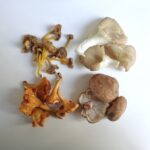
Wild mushroom risotto
This earthy risotto may be prepared well in advance. The original — created by one of my favorite Paris chefs, who was kind enough to share the recipe — uses petit épeautre, or einkorn wheat, a rustic grain with a nutty flavor. But if this is hard to find where you live, you can substitute a risotto rice such as Arborio or Carnaroli, to equally spectacular effect.
The grain is cooked in broth and may be set aside when al dente. The mushrooms are sautéd separately with minced shallot and garlic, the pan is deglazed with white vermouth (or white wine) and cream is added to make an unctuous sauce. Just before serving, the grain and mushrooms are combined and gently reheated, with grated parmesan and a sprinkle of parsley added at the end. The creator of this recipe, chef John O’Shea of the restaurant JJ Beaumarchais, says to aim to have about the same volume of cooked grain as mushrooms in their sauce. But this is not an exact science. You can improvise.
For best results, make the broth yourself (this may also be done well ahead of time). I recommend homemade chicken broth or, for vegetarians, homemade vegetable broth.
 As for the wild mushrooms, you can use whatever is available in your region, preferably a combination. For the risotto in the photo above, I used the mushrooms pictured at right. Going clockwise from top left, they are, in French, chanterelles, pleurotes, shitake and girolles. I have also used trompettes de la mort. You can throw in a few regular mushrooms as well.
As for the wild mushrooms, you can use whatever is available in your region, preferably a combination. For the risotto in the photo above, I used the mushrooms pictured at right. Going clockwise from top left, they are, in French, chanterelles, pleurotes, shitake and girolles. I have also used trompettes de la mort. You can throw in a few regular mushrooms as well.
The quantities below will serve 2 people as a main dish and 3-4 as a starter or side dish.
1 cup uncooked grain (170 g petit épeautre/einkorn wheat, or 185 g risotto rice)
2 cups (250 ml) broth (see above), with extra as needed
12 ounces (350 g) wild mushrooms
2 tbsp. olive oil
1 tsp. butter
2 shallots
1 clove garlic
1/4 cup (60 ml) white vermouth or dry white wine
3/4 cup (180 ml) heavy cream
1/4 tsp. salt, or more to taste
freshly ground black pepper
4 tbsp. grated parmesan
a few sprigs flat-leaf parsley
Combine the grain and broth in a saucepan. Bring to a boil. Reduce the heat and simmer for about half an hour, until the grain is al dente and most or all of the broth is absorbed. If the liquid is absorbed before the grain is tender, add a little more broth or some water.
While the grain is cooking, clean the mushrooms. I find that the best way to get bits of forest off wild mushrooms is to use a salad spinner. Remove the basket from the spinner and fill the outer container with cool water. Immerse the mushrooms — bits of fern and dried leaves will float to the surface. Now transfer the mushrooms to the basket, empty the container and spin the mushrooms dry. Then check the mushrooms one by one, paring away the stem bottoms and removing any remaining bits of forest.
Before cooking the mushrooms, peel and mince the shallots and garlic, and have the vermouth or wine and the cream standing ready.
Heat the olive oil in a large skillet. When it sizzles, add the mushrooms. Sauté over high heat, stirring, until the mushrooms release and absorb their juices and begin to brown.
Now add the butter, shallots and garlic. When the shallots have wilted, add the vermouth or wine. Scrape the skillet with a wooden spatula to incorporate the browned bits from the bottom. When all the liquid has evaporated, add the cream. Heat through, stirring, until the cream thickens into an unctuous sauce.
Your grain and mushrooms are now ready to be combined.
Before beginning the final stage of preparation, strip some leaves from the parsley stems and snip enough to make about 2 tbsp. of snipped leaves.
Now gently reheat the grain, adding a little more liquid if necessary to prevent sticking. Stir in the mushrooms and their sauce. When the risotto is simmering and most of the liquid is absorbed, stir in the parmesan and snipped parsley. Serve piping hot.
Serves 2 as a main dish, and 3-4 as a starter or side dish.
If serving as a main dish, serve in shallow bowls with a salad alongside, and perhaps a cheese plate to follow. As a side dish, this risotto marries beautifully with roasted poultry, meat or fish, and would also go well with vegetarian dishes like roasted winter vegetables or butternut with pine nuts in the cool months, or braised asparagus or roasted eggplant in spring or summer. As for wine, I’d recommend a sturdy red, for example Côtes du Rhone or Bordeaux. Bon appétit!




